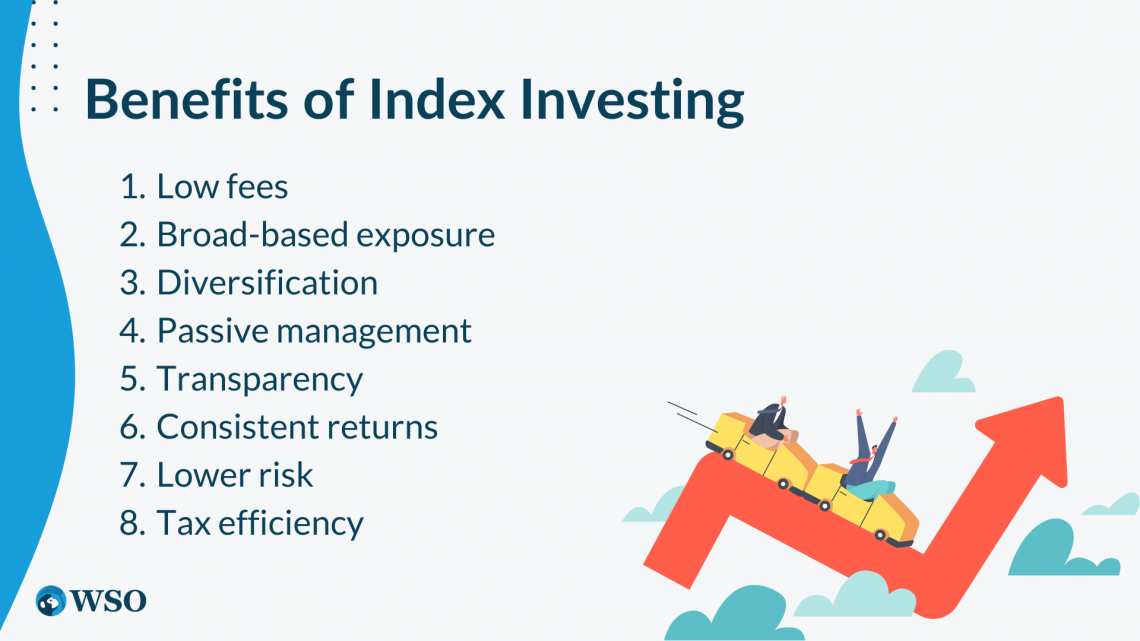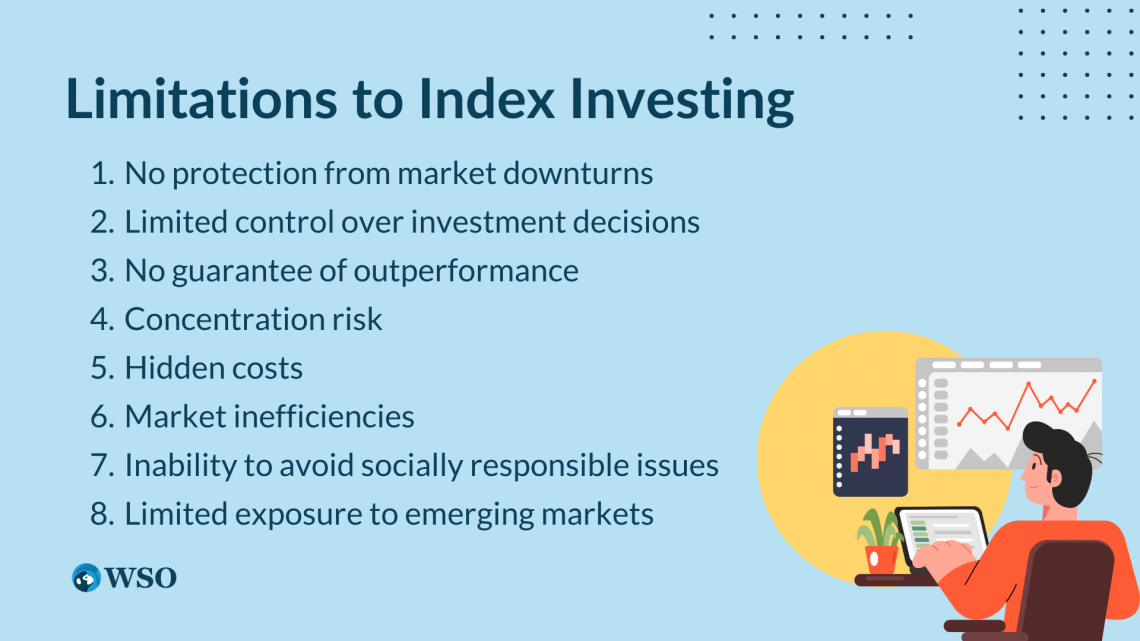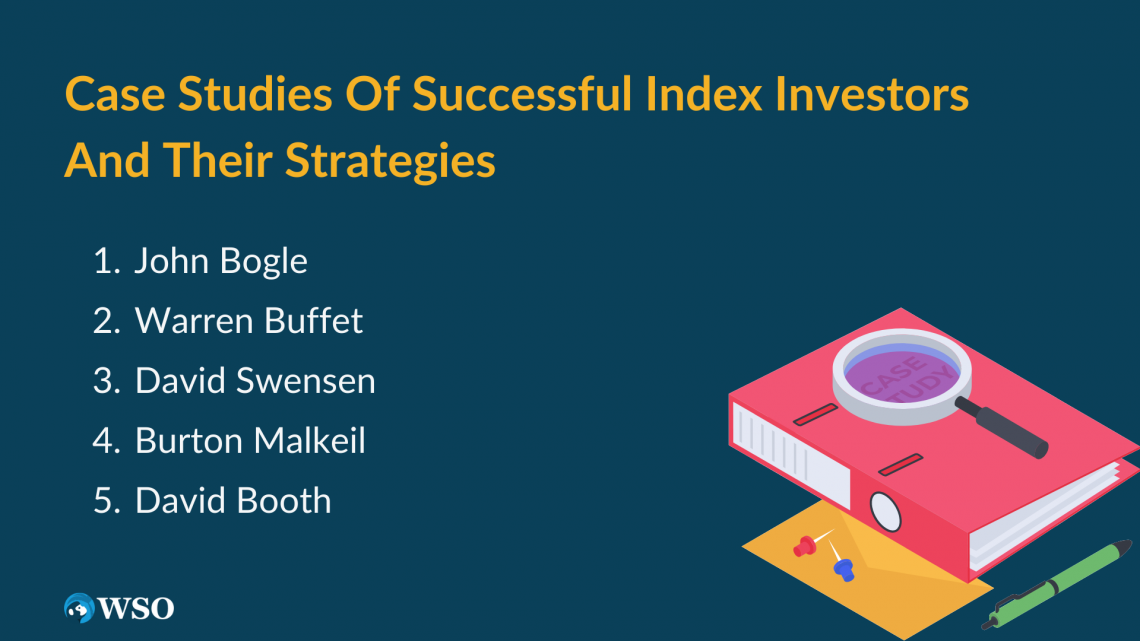Index Investing
Index investing is a philosophy where investing is done in a portfolio of assets that mimic a particular index or financial market.
Index investing (II) or Indexing is an investment strategy investors adopt to generate returns similar to a stock market index.

Instead of trying to earn profits in the market by selecting individual stocks, investors typically buy a fund replicating the index's composition by investing in all or a representative sample of the securities in the index.
These funds are usually set up and traded as ETFs or Mutual Funds. Full replication is a process where the fund holds all the securities in the index in the same weightings as the index itself.
Alternatively, sampling is where the funds hold a representative sample of securities from the index that closely mirrors the index's risk and return characteristics.
II dates back to the 1970s when Jack Bogle, Vanguard Group’s founder, noticed that most active fund managers failed to outperform the market consistently, and their high fees eroded returns.
An index fund aims to mimic the index as precisely as possible so that its risks and returns are proportional to the index. This is typically achieved through full replication or sampling.
Bogle introduced the concept of II by introducing the Vanguard 500 - the first index fund in a belief that investors would be better off investing in a low-cost, passive fund that simply tracked the market index's performance.
Index funds are passively managed and have lower fees than actively managed funds, as they do not require as much research and analysis to select individual securities.
This can lead to higher returns over the long term, as lower fees mean that the investor retains more of the returns generated by the fund.
- Index investing (II) or Indexing is an investment strategy investors adopt to generate returns similar to a stock market index.
- An index fund aims to mimic the index as precisely as possible so that its risks and returns are proportional to the index.
- This is typically achieved through full replication or sampling.
- Index funds are passively managed and have lower fees than actively managed funds, as they do not require as much research and analysis to select individual securities.
- Investors can receive exposure to a diverse portfolio of equities representing the whole market or industry by investing in indices.
How does index investing work?
It involves the following steps:

Step 1 - Choosing an index
Selecting the index to track is the first stage in the indexing process. The index should reflect the industry or market the investor wants to invest in. This can be done by researching different indices and selecting one that meets the investor's objectives.
For instance, the MSCI EAFE index covers companies in developed countries outside North America, but the widely used S&P 500 index reflects the largest 500 corporations in the United States.
Step 2 - Investing in an index fund
The fund manager chooses the index and then builds a portfolio of securities that closely mirrors the index's makeup. This is done through either full replication or sampling.
a) Full replication
This involves buying all of the securities in the index in the same weightings as the index itself. So, for instance, if ABC Ltd. comprises 5% of the index, the fund will invest 5% of its assets.
b) Sampling
This involves holding a representative sample of securities from the index that closely mirrors the index's risk and return characteristics. Since fewer securities must be acquired and sold, this may be more economical than full replication.
Step 3 - Passive management
Index funds are passively managed, meaning they do not try to outperform the market by picking individual stocks. Instead, they seek to track the index as closely as possible.
This is achieved by investing in the same stocks and maintaining the same weightings as the underlying index. In addition, passive management reduces the costs associated with research and analysis, which can lead to lower fees for investors.
Passive management also helps to reduce the impact of individual stock selection, as the fund is invested in a diversified basket of securities representing the overall market or sector.
Investors may pay lower fees because passive management makes research and analysis less expensive. In addition, as the fund is invested in a diversified basket of securities representing the entire market or sector, it also helps lessen the impact of individual stock selection.
Step 4 - Diversification
Investors can receive exposure to a diverse portfolio of equities representing the whole market or industry by investing in an index fund.
This helps to reduce risk, as gains in others typically offset any losses incurred by one stock or sector.

For instance, while purchasing a DJIA index fund, the investor gains exposure to many sectors, such as healthcare, finance, education, and infrastructure. This lowers the chance of being overly exposed to one sector, which can be advantageous when the market is volatile.
Step 5 - Rebalancing
Index funds are periodically rebalanced to maintain the correct weightings of securities in the portfolio. This ensures that the fund continues to track the index as closely as possible.
Rebalancing involves changing a portfolio's holdings to keep the desired asset allocation.
In the context of index investing, rebalancing is where we adjust the weights of the securities in an index fund according to the underlying index. As a result, the fund can follow the index as closely as possible over time.
Rebalancing can aid in risk management and portfolio consistency regarding diversification.
If holdings are balanced regularly, the risk of loss from one stock or sector is inherently avoided. This ultimately results in long-term profits.
Impact of Index Investing on stock markets
Key ways II affects the stock market are

1. Capital concentration
Index investment has resulted in a concentration of capital in a select group of sizable firms that compose the majority of market indices. The market capitalization of these businesses rises as more investors opt to invest in index funds, thus enhancing their dominance.
2. Changes in stock prices
The money from index investing has enhanced the demand for the equities featured in index funds. As a result, stock prices have increased, which has decreased market volatility because index funds often invest in a diverse portfolio of equities that help lower risk.
3. Reduced volatility
Due to index funds investing in a diverse array of stocks, index investing has resulted in decreased stock market volatility.
Diversification helps to reduce risk and can lead to more stable returns over time.
4. Changes in corporate behavior
Changes in corporate behavior are another result of the capital concentration in a small number of large companies.
As these companies gain market dominance, they can be less inclined to invest in or innovate on new initiatives, preferring to concentrate on preserving their position in the market and maximizing shareholder profits.
5. Impact on active management
The rise of IIhas also impacted active management. The need for actively managed funds may decrease as more investors participate in index funds.
As a result, the market's structure may change as fewer individuals actively participate in choosing their investments.
6. Market efficiency
Since index funds offer investors a cheap and effective way to engage in the market, II has helped to boost market efficiency.
This increased efficiency can lead to more accurate pricing of individual stocks and a more transparent market overall.
Benefits of Index Investing
There are several benefits to index investing. Here are some key advantages:

1. Low fees
Index funds are passively managed and have lower fees than actively managed funds, as they do not require as much research and analysis to select individual securities. This translates into greater long-term returns for the investment as the investor keeps more of the fund's returns.
2. Broad-based exposure
Indexing gives investors access to various businesses in a given market or industry. As a result, investors are less exposed to the risks involved with individual stocks when they invest in a fund that follows a broad index.
3. Diversification
Index Investing helps investors in diversification. In addition, because one fund comprises securities from different sectors, it makes a good option for investors.
Since gains in different sectors often balance losses in one stock or sector, this helps to mitigate risk.
4. Passive management
Index funds are passively managed, requiring less research and analysis than actively managed funds. This provides a more practical option for beginning investors or those who take a less involved approach to investing.
5. Transparency
Thanks to the regular disclosure of index funds ' holdings, investors may easily understand exactly what they are investing in. In addition, investors may see that the fund closely matches the index, which can increase their trust and confidence in the fund by tracking the index as closely as possible.
6. Consistent returns
It seeks to replicate the performance of a particular market index. This means the returns are typically more consistent than actively managed funds, which may outperform in some years but underperform in others.
7. Lower risk
II lowers risk than investing in individual stocks or actively managed funds for investors. This is due to the money invested in a diverse portfolio of equities representing the entire market or sector.
8. Tax efficiency
Index funds are typically more tax efficient than actively managed funds. This is because they have lower turnover and are less likely to generate capital gains distributions, which can be taxable for investors.
Limitations to Index Investing
Index Investing is beneficial to investors in many ways. However, it has the following limitations.

1. No protection from market downturns.
Index funds are made to duplicate an underlying index's performance. As a result, index funds will lose value when the market is down, giving investors little protection from market turbulence.
2. Limited control over investment decisions.
Index funds track a predetermined list of stocks and do not allow investors to choose individual stocks. As a result, investors lose control over their investments, and taking advantage of special market opportunities becomes difficult.
3. No guarantee of outperformance.
While index investing may provide consistent returns, it does not guarantee outperformance compared to actively managed funds or individual stocks. As a result, investors may miss out on potentially good returns by solely relying on index funds.
4. Concentration risk
Index funds are often weighted toward a few large companies in the index, leading to concentration risk.
A significant downturn in one of these companies could significantly impact the index fund's performance.
5. Hidden costs
Index funds may have hidden costs, such as tracking errors, which can result in lower returns than expected. Additionally, some index funds incur high expenses, ultimately reducing the return over the long term.
6. Market inefficiencies
Index investing assumes that markets are always efficient and that stock prices always reflect the company's underlying fundamentals. As a result, investors might lose out on potential profits, as this may only be the case sometimes.
7. Inability to avoid socially responsible issues.
Index funds may invest in companies with controversial practices or unethical behavior, as they are designed to track the index's performance regardless of the company's ethical or social responsibility. This might go against the values of some investors.
8. Limited exposure to emerging markets.
Index investing may need adequate exposure to emerging markets, potentially offering higher returns than developed markets.
Index Investing vs. Active Management
Active management is an investment strategy where investors choose particular stocks or industry sectors they think will outperform the market to beat the market. Active managers analyze financial statements, economic data, and market trends to identify undervalued stocks or sectors.

Index investing, conversely, is based on the theory that states it is impossible to beat the market consistently over the long term, commonly referred to as the efficient market hypothesis.
Here are some key differences between II and active management:
| Index Investing | Active Management |
|---|---|
| Passive investment strategy | Active investment strategy |
| Aims to replicate the performance of a market index | Aims to beat the market by selecting specific stocks or sectors |
| Lower management fees compared to actively managed funds | Higher management fees compared to index funds |
| Diversification through investing in a wide range of stocks | Selective investment in specific stocks or sectors |
| Not flexible - cannot take advantage of market inefficiencies | Flexible - can take advantage of market inefficiencies |
| Low turnover rate and tax-efficient | High turnover rate and may be tax-inefficient |
| No attempt to time the market or pick stocks | Attempts to time the market or pick individual stocks |
| May provide steady returns over the long term | May provide higher returns over the short term |
| More suitable for investors who prioritize long-term growth and are comfortable with market fluctuations | More suitable for investors who prioritize short-term gains and are comfortable with taking on higher risk |
| Examples include index funds and ETFs | Examples include actively managed mutual funds and hedge funds |
Case Studies of Successful Index Investors and their strategies
Case studies of successful index investors and their strategies can offer insightful information for those looking to invest in the market. Here are a few prosperous index investors and their techniques:

1. John Bogle
John Bogle, the founder of Vanguard, is credited with popularizing index investing. His strategy involved creating low-cost, passively managed funds that sought to track broad market indices. S&P 500 was certainly his favorite.
Bogle believed that actively managed funds were unsuitable for most investors due to their high fees and potential for underperformance.
Many investors reached their financial objectives because of his straightforward and successful strategy.
2. Warren Buffet
One of the greatest investors of all time, Warren Buffett, recently got around to index investing. Despite his stellar reputation as a stock picker, Buffett has advised many investors to use inexpensive index funds.
Buffet thinks that rather than trying to outperform the market with specific stock choices, most investors would be better served buying a broad portfolio of equities. He also stated that he intends to have his wife put most of his fortune in index funds after his passing.
3. David Swensen
David Swensen, the chief investment officer of Yale University's endowment, is another successful index investor. Using a variety of asset classes, such as equities, bonds, and real estate.
Swensen's technique aims to build a diversified portfolio that can withstand market turbulence.
Additionally, he strongly supports low-cost index funds, which in his opinion, provide most investors with the best long-term returns.
4. Burton Malkeil
Another well-known proponent of index investing is author and professor Burton Malkiel of Princeton University. His approach entails investing in large market indices like the Wilshire 5000 and holding such holdings for a considerable time.
Burton thinks that investors can obtain high returns while lowering risk by resisting the urge to try to beat the market with individual stock picks.
5. David Booth
A pioneer in factor-based investing is Dimensional Fund Advisors co-founder David Booth. His approach is leveraging academic research to pinpoint market elements like value and momentum that have historically produced impressive returns.
Booth thinks investors might obtain better returns by investing in index funds that monitor these variables instead of a conventional market-cap-weighted index.




or Want to Sign up with your social account?